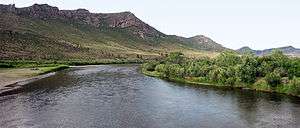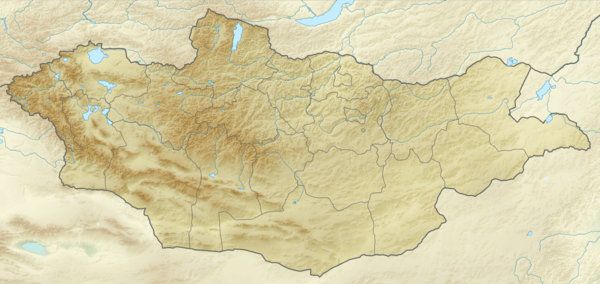Onon-Balj National Park
Onon-Balj National Park (Mongolian: Онон Балж) covers two sectors of the Onon River valley as it flows north from Mongolia into Russia. The region is in the transition zone between the Siberian conifer forests of the north and the Daurian steppe and forest steppe of Mongolia. The area is one of relatively high biodiversity, and is also historically and culturally important for its association with Genghis Khan. The park is located in the far northeast of Khentii Province, 280 km northeast of Ulaanbataar.[1][2][3]
| Onon-Balj National Park | |
|---|---|
| Mongolian: Онон Балж | |
IUCN category II (national park) | |
 Onon River | |
 Location of Park | |
| Location | Mongolia |
| Nearest city | Dadal |
| Coordinates | 48.98°N 111.1°E |
| Area | 4,158 square kilometres (1,605 sq mi) |
| Established | 2011 |
| Governing body | Ministry of Environment and Green Development of Mongolia |
Topography
The park covers mid-sized mountains and confluence of the Onon and Balj Rivers.[2][4] Elevations range from 840 meters at the Onon River, to 1,568 meters at Kentsuu Mountain. The mountains generally have rounded tops and mild slopes.[5]
Climate and ecoregion
The climate of the area is Cold semi-arid climate (Köppen climate classification (BSk)). This climate is characteristic of steppe climates intermediary between desert humid climates, and typically have precipitation is above evapotranspiration. At least one month averages below 0 °C (32 °F).[6][7] The park is in southern extent of the Trans-Baikal conifer forests ecoregion.
Flora and fauna
Vegetation varies with river courses - willow groves, floodplain and riparian forests - and with altitude on the mountains - steppe and forest steppe. The forests are characterized by pine and larch trees.[2] A significant threat to habitat in the park is currently forest fires.[8] Birds known to breed in the park include the vulnerable Swan Goose (Anser cygnoides), Lesser kestrel (Falco naumanni), and the vulnerable White-naped crane (Antigone vipio). Mammals include the Daurian ground squirrel and the Raccoon dog.
References
- "Onon-Balj National Park, Management Plan" (PDF) (in Mongolian). Official park Management Plan. Retrieved April 18, 2020.
- "Onon-Balj". Birdlife International. Retrieved April 18, 2020.
- "Implementation of the Wildlife Picture Index in Mongolia 2010" (PDF). National University of Mongolia. Retrieved April 25, 2020.
- "Onon-Balj National Park" (in Mongolian). Official Facebook page of Onon-Balj NP. Retrieved April 25, 2020.
- "Onon-Balj National Park". Onon-Balj Park Administration, WWF. Retrieved April 25, 2020.
- Kottek, M., J. Grieser, C. Beck, B. Rudolf, and F. Rubel, 2006. "World Map of Koppen-Geiger Climate Classification Updated" (PDF). Gebrüder Borntraeger 2006. Retrieved September 14, 2019.CS1 maint: multiple names: authors list (link)
- "Dataset - Koppen climate classifications". World Bank. Retrieved September 14, 2019.
- "The Way Forward - WWF Mongolia" (PDF). WWF Mongolia. Retrieved April 25, 2020.